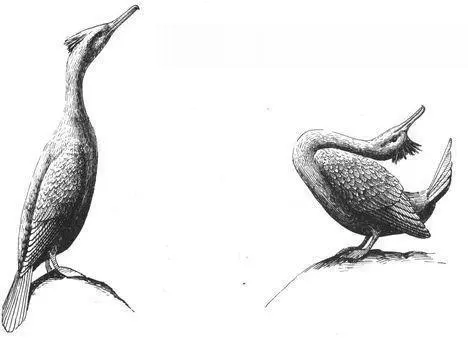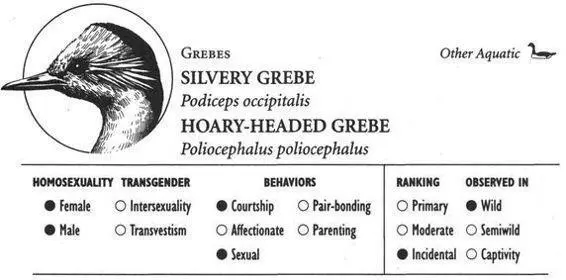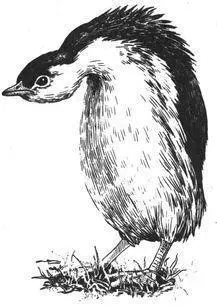Frequency: Homosexual pairs and courtship occur only occasionally in these two species: no more than perhaps 1 in 500 pairs of Great Cormorants, for example, is composed of two males.
Orientation: Great Cormorants in homosexual pairs are sometimes sequentially bisexual, divorcing their male partners and going on to breed in heterosexual pairs. However, others re-pair with another male partner, and some homosexual pairs appear to last much longer, perhaps even for the birds’ lifetimes—in which case such individuals are exclusively (or extensively) homosexual for a significant part of their lives. Male European Shags that court other males are simultaneously bisexual, alternating heterosexual courtship with homosexual interactions (and probably a greater proportion of the former).
Nonreproductive and Alternative Heterosexualities
Several forms of nonprocreative sexual behavior are exhibited by these Cormorants. REVERSE mountings constitute 8 percent of European Shag heterosexual copulations (and also occur in Great Cormorants), while at least a quarter of all sexual activity takes place prior to the female’s fertilizable period. Great Cormorants sometimes copulate during the incubation period, while heterosexual copulations may continue even after Shag chicks have hatched. In a few cases, adult male Shags have been observed mating with their own chicks, and incestuous pairings sometimes also develop between brothers and sisters when they are still young. Nearly half of all heterosexual copulations in Shags involve mounting without genital contact, often because the female will not permit it. In addition, males are frequently hostile to females during the early phases of courtship (as noted above).
Courtship between two male European Shags: the “upright-aware” posture ( left ) and the “throw-back” display

Nonmonogamous matings and courting of birds other than one’s partner occur in both of these species. In European Shags, for example, 14 percent of all copulations are promiscuous. Almost 18 percent of all chicks are fathered by a male other than their mother’s mate, but nearly 80 percent of all nonmonogamous matings are nonreproductive, taking place before females can be fertilized. At least 4 percent of all chicks are related to neither of the parents caring for them; this results from adoption and from females’ laying eggs in nests other than their own. About 3–5 percent of male Shags bond polygamously with two females; in addition, 30–40 percent of heterosexual Shag pairs divorce and re-pair with new mates the next season. Individuals may also change mates during the season. Some Shag parents are severely neglectful, refusing to feed their offspring, who may, as a result, die of starvation. In addition, about a third of all eggs lost through breakage result from interference by the females in polygamous associations. Finally, nonbreeding is a regular feature of some Shag populations: on average, 12–25 percent of all adults skip breeding at least once during their lifetime, and in some years as many as 60 percent of all birds forgo reproduction.
Sources
*asterisked references discuss homosexuality/transgender
Aebischer, N. J., G. R. Potts, and J. C. Coulson (1995) “Site and Mate Fidelity of Shags Phalacrocorax aristotelis at Two British Colonies.” Ibis 137:19–28.
Aebischer, N. J., and S. Wanless (1992) “Relationships Between Colony Size, Adult Non-Breeding, and Environmental Conditions for Shags Phalacrocorax aristotelis on the Isle of May, Scotland.” Bird Study 39:43–52.
*Fukuda, M. (1992) “Male-Male Pairing of the Great Cormorant (Phalacrocorax carbo hanedae).” Colonial Waterbird Society Bulletin 16:62–63.
Graves, J., R. T. Hay, M. Scallan, and S. Rowe (1992) “Extra-Pair Paternity in the Shag, Phalacrocorax aristotelis as Determined by DNA Fingerprinting.” Journal of Zoology, London 226:399–408.
Harris, M. P. (1982) “Promiscuity in the Shag as Shown by Time-Lapse Photography.” Bird Study 29:149–54.
Johnsgard, P. A. (1993) Cormorants, Darters, and Pelicans of the World. Washington and London: Smithsonian Institution Press.
*Kortlandt, A. (1995) “Patterns of Pair-Formation and Nest-Building in the European Cormorant, Phalacrocorax carbo sinensis.” Ardea 83:11–25.
*———(1949) “Textuur en structuur van het broedvoorbereidingsgedrag bij de aalscholver [Texture and Structure of Brooding-Preparatory Behavior in the Cormorant].” Ph.D. thesis, University of Amsterdam.
*Snow, B. K. (1963) “The Behavior of the Shag.” British Birds 56:77—103, 164—86.

SILVERY GREBE
IDENTIFICATION: A ducklike bird with grayish white plumage, bright red eyes, and yellow facial tufts. DISTRIBUTION: Western and southern South America. HABITAT: Lakes, marshy ponds. STUDY AREA: Laguna Nevada, southern Patagonia, Argentina.
HOARY-HEADED GREBE
IDENTIFICATION: Similar to Silvery Grebe, but with a buff or chestnut wash on the breast, white streaks on the head, and black-and-white eyes. DISTRIBUTION: Australia, Tasmania. HABITAT: Wetlands, estuaries, bays. STUDY AREA: Lake Bathurst, New South Wales, Australia.
Social Organization
Both of these species of Grebes commonly socialize in pairs or small groups, and sometimes in dense flocks (which may contain several thousand birds in Hoary-headed Grebes). They nest in large colonies—up to 400 nests for Hoary-headed Grebes—and most form monogamous pair-bonds.
Description
Behavioral Expression: Male Silvery Grebes occasionally mount other males, using the same position as for heterosexual copulation—although unlike in heterosexual mating, the mounted bird does not typically invite the other male to mount him. In Hoary-headed Grebes, two birds of the same sex sometimes perform courtship displays to each other on floating platforms, constructed of water vegetation, and perhaps also mount one another. One such display is called REARING, in which the bird lifts its body up, ruffles its mantle feathers, and extends its head and neck downward. This may lead to one bird INVITING the other to mount, by settling back down, kinking its neck, and resting its throat on the nest.
The “rearing” display of a Hoary-headed Grebe, used during courtships with same- and opposite-sex partners

Frequency: Same-sex activity occurs only occasionally in these two species of Grebes. In Silvery Grebes, for example, about 1 in 300 mounts is between two males.
Orientation: Grebes that participate in same-sex activities are probably bisexual, also courting and mating with members of the opposite sex.
Nonreproductive and Alternative Heterosexualities
In these two species of Grebes—as in many other Grebes—REVERSE heterosexual mountings are common. An average of 27 percent of all copulations among Silvery Grebes involve females mounting males, and early in the breeding season as many as 40 percent of all mounts are reverse. Their prevalence during this period—long before fertilization is possible—indicates that this form of behavior is decidedly nonprocreative. In addition, ejaculation does not usually occur during reverse mounts, although females typically perform tail thrusting, perhaps to facilitate genital contact. Grebes also copulate repeatedly, with as many as five or six matings taking place over 15–20 minutes; during this activity, males and females may also alternate positions in a form of reciprocal mounting. Although most heterosexual mating in Hoary-headed Grebes takes place between pair members, some copulations also occur between unpaired birds.
Читать дальше















